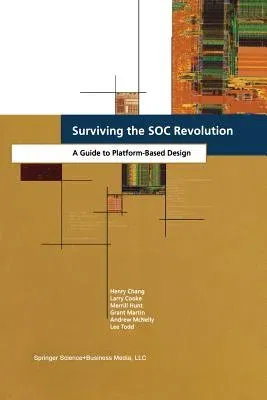The aim of Surviving the SOC Revolution: A Guide to Platform-Based
Design is to provide the engineering community with a thorough
understanding of the challenges involved when moving to system-on-a-chip
and deliver a step-by-step methodology to get them there.
Design reuse is most effective in reducing the cost and development time
when the components to be shared are close to the final implementation.
On the other hand, it is not always possible or desirable to share
designs at this level, since minimal variations in specification can
result in different, albeit similar, implementations. However, moving
higher in abstraction can eliminate the differences among designs, so
that the higher level of abstraction can be shared and only a minimal
amount of work needs to be carried out to achieve final
implementation.
The ultimate goal is to create a library of functions and of hardware
and software implementations that can be used for all new designs. It is
important to have a multilevel library, since it is often the case that
the lower levels that are closer to the physical implementation change
because of the advances in technology, while the higher levels tend to
be stable across product versions.
It is most likely that the preferred approaches to the implementation of
complex embedded systems will include the following aspects:
Design costs and time are likely to dominate the decision-making process
for systems designers. Therefore, design reuse in all its shapes and
forms will be of paramount importance.
Designs have to be captured at the highest level of abstraction to be
able to exploit all the degrees of freedom that are available.
Next-generation systems will use a few highly complex (Moore's Law
Limited) part-types, but many more energy-power-cost-efficient,
medium-complexity (10M-100M) gates in 50nm technology chips, working
concurrently to implement solutions to complex sensing, computing, and
signaling/actuating problems.
Such chips will most likely be developed as an instance of a particular
platform. That is, rather than being assembled from a collection of
independently developed blocks of silicon functionality, they will be
derived from a specific `family' of rnicro-architectures, possibly
oriented toward a particular class of problems, that can be modified
(extended or reduced) by the system developer.
These platforms will be highly programmable.
Both system and software reuse impose a design methodology that has to
leverage existing implementations available at all levels of
abstraction. £/LIST£
This book deals with the basic principles of a design methodology that
addresses the concerns expressed above. The platform concept is carried
throughout the book as a unifying theme to reuse. This is the first book
that deals with the platform-based approach to the design of embedded
systems and is a stepping stone for anyone who is interested in the real
issues facing the design of complex systems-on-chip.
From the Preface by Alberto Sangiovanni-Vincentelli


